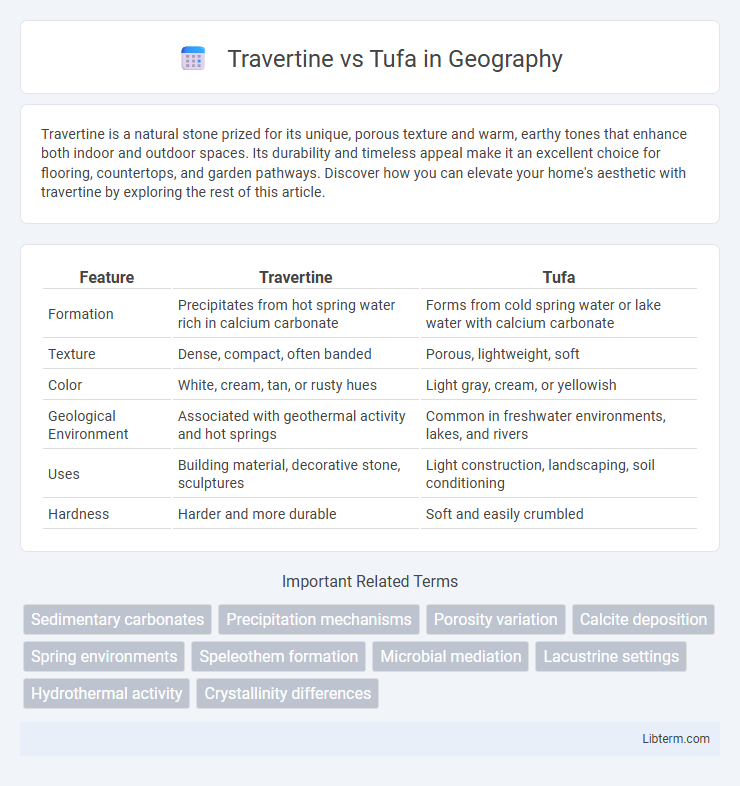Travertine is a natural stone prized for its unique, porous texture and warm, earthy tones that enhance both indoor and outdoor spaces. Its durability and timeless appeal make it an excellent choice for flooring, countertops, and garden pathways. Discover how you can elevate your home's aesthetic with travertine by exploring the rest of this article.
Table of Comparison
| Feature | Travertine | Tufa |
|---|---|---|
| Formation | Precipitates from hot spring water rich in calcium carbonate | Forms from cold spring water or lake water with calcium carbonate |
| Texture | Dense, compact, often banded | Porous, lightweight, soft |
| Color | White, cream, tan, or rusty hues | Light gray, cream, or yellowish |
| Geological Environment | Associated with geothermal activity and hot springs | Common in freshwater environments, lakes, and rivers |
| Uses | Building material, decorative stone, sculptures | Light construction, landscaping, soil conditioning |
| Hardness | Harder and more durable | Soft and easily crumbled |
Introduction to Travertine and Tufa
Travertine and tufa are both natural sedimentary rocks formed from calcium carbonate deposits, commonly used in construction and landscaping. Travertine is characterized by its dense, fibrous texture and smooth surface, often exhibiting a range of earthy colors from white to cream and tan, making it popular for flooring, wall cladding, and outdoor patios. Tufa, by contrast, is lighter and more porous, with a softer texture that has historically been used in sculpting and as a building material in regions like Italy and the Mediterranean.
Geological Formation Processes
Travertine forms primarily through the rapid precipitation of calcium carbonate from mineral-rich hot springs or groundwater, resulting in dense, banded layers of calcite or aragonite. Tufa develops via the slower deposition of calcium carbonate from ambient temperature waters, often in freshwater lakes or streams, creating porous, lightweight rock structures with abundant organic material. These distinct geological formation processes influence their textures, densities, and typical environmental occurrences within sedimentary rock settings.
Key Physical Characteristics
Travertine exhibits a dense, fibrous texture with a smooth, creamy surface, often featuring natural pitting and concentric banding due to calcium carbonate deposits from mineral springs. Tufa, by contrast, is a porous, lightweight limestone with a more spongy appearance, formed by rapid precipitation of calcium carbonate in cooler waters such as rivers and lakes. The hardness of travertine typically ranges between 4 and 5 on the Mohs scale, making it more durable than tufa, which is softer and more brittle due to its highly porous structure.
Mineral Composition Comparison
Travertine primarily consists of calcium carbonate (CaCO3) with a crystalline structure formed from rapid precipitation of calcium-rich water in hot springs or limestone caves. Tufa, also composed mainly of calcium carbonate, differs by its porous and softer texture due to lower density and the inclusion of organic material and impurities during slower deposition in ambient temperature waters. The mineralogical distinction lies in travertine's dense, banded calcite layers versus tufa's highly porous, less compacted matrix enriched with aragonite and detrital sediments.
Color and Texture Differences
Travertine typically features warm, earthy tones ranging from creamy beige to deep honey, with a smooth, porous texture marked by natural pitting and fibrous veining. Tufa, on the other hand, exhibits softer, pale shades such as light gray, white, or subtle tan, with a more porous, spongy texture due to its volcanic origin. The color and texture differences make travertine suitable for polished architectural finishes, while tufa's rough, lightweight structure lends itself to rustic or historical applications.
Major Global Locations and Sources
Travertine is predominantly quarried in Italy, particularly near Tivoli and Rome, along with significant deposits in Turkey, Iran, and the United States, especially in Yellowstone National Park. Tufa mainly forms in freshwater regions with extensive sources in California, USA, and Lake Mono, while notable formations exist in Italy and northern Europe. These geological settings contribute to the distinct porosity and mineral composition differentiating travertine's dense, layered deposits from tufa's softer, more porous texture.
Common Uses in Architecture and Design
Travertine is extensively used in flooring, wall cladding, and bathroom surfaces due to its durability and natural porous texture, offering a classic aesthetic in both indoor and outdoor architecture. Tufa, lighter and more porous, is favored for decorative elements, garden walls, and sculptures, providing a softer, rustic look often seen in Mediterranean and historical structures. Both stones enhance architectural design by balancing functionality with natural beauty, but travertine's sturdiness makes it more suitable for high-traffic areas while tufa excels in ornamental applications.
Durability and Maintenance Factors
Travertine exhibits superior durability compared to tufa due to its denser mineral composition, making it more resistant to weathering and physical wear. Tufa, being softer and more porous, requires frequent sealing and careful maintenance to prevent erosion and staining over time. Choosing travertine for flooring or exterior applications often results in lower maintenance costs and longer-lasting performance.
Environmental Impact and Sustainability
Travertine and tufa, both natural sedimentary stones, differ significantly in environmental impact and sustainability. Travertine extraction involves intensive quarrying that disrupts landscapes and consumes substantial water resources, while tufa forms through low-energy processes and can be harvested with less environmental degradation. Tufa's porous, lightweight nature allows for more sustainable use in eco-friendly construction, reducing energy consumption compared to the denser, heavier travertine.
Choosing Between Travertine and Tufa
Choosing between travertine and tufa depends on the intended use and aesthetic preferences, as travertine offers a denser, more durable surface ideal for flooring and countertops, while tufa's porous and lightweight structure suits garden landscaping and decorative applications. Travertine forms from mineral springs and features rich, layered textures with varying hardness, contrasting with tufa, which is a softer, more porous limestone deposited around freshwater sources. Consider factors like durability, maintenance, and environmental exposure to ensure the right selection for construction or design projects.
Travertine Infographic

 libterm.com
libterm.com